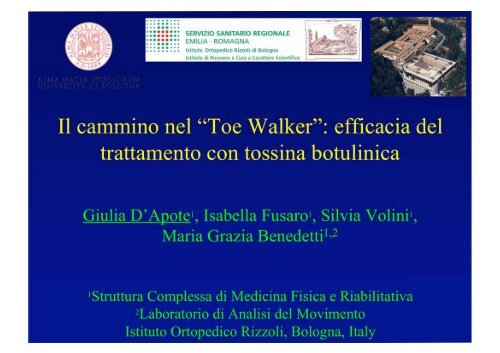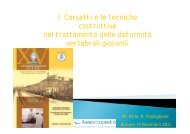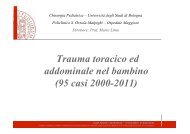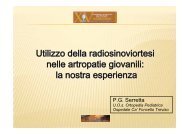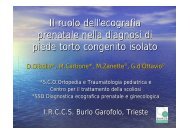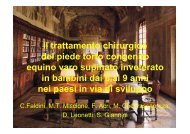toe-walking idiopatico - CSR Congressi srl
toe-walking idiopatico - CSR Congressi srl
toe-walking idiopatico - CSR Congressi srl
You also want an ePaper? Increase the reach of your titles
YUMPU automatically turns print PDFs into web optimized ePapers that Google loves.
Il cammino nel “Toe Walker”: efficacia del<br />
trattamento con tossina botulinica<br />
Giulia D’Apote 1, Isabella Fusaro 1, Silvia Volini 1,<br />
Maria Grazia Benedetti 1,2<br />
1Struttura Complessa di Medicina Fisica e Riabilitativa<br />
2 Laboratorio di Analisi del Movimento<br />
Istituto Ortopedico Rizzoli, Bologna, Italy
TOE-WALKING IDIOPATICO<br />
Condizione che si osserva tipicamente nell’età infantile, caratterizzata da<br />
pattern di cammino abituale sulle punte in assenza di causa nota.<br />
Oltre i due anni di età, la diagnosi è di esclusione:<br />
Paralisi Cerebrale Infantile o forme familiari<br />
malattie neuromuscolari o disrafismi<br />
patologie ortopediche<br />
disturbi comportamentali come autismo, disordini comunicativi, disturbi<br />
dell’apprendimento
CONSEGUENZE A LUNGO<br />
CONSERVATIVO<br />
• Uso di tutori<br />
• Stretching<br />
TERMINE<br />
• Sviluppo di piede equino strutturato<br />
• Sovraccarico lombare<br />
• Sviluppo di patologie del rachide<br />
TRATTAMENTO<br />
Hirsch G, Wagner B. The natural history of<br />
idiopathic <strong>toe</strong> – <strong>walking</strong> : a long term follow –<br />
up of fourteen conservatively treated children.<br />
Acta paediatr. 2004 Feb; 93(2):196-9.<br />
Taussig G, Delouvée E. Idiopathic <strong>toe</strong> walker<br />
child. Diagnosis and spontaneous evolution.<br />
Ann Readapt Med Phys. 2001 Jul;44(6):333-9.<br />
NON CONSERVATIVO<br />
• Allungamento chirurgico del<br />
Tendine di Achille
SCOPO DELLO STUDIO<br />
Valutare l’efficacia della Tossina Botulinica<br />
nel trattamento del piede equino<br />
nel bambino “Toe-walker” <strong>idiopatico</strong><br />
Il razionale all’uso della tossina<br />
in tali pazienti è basato sul<br />
rilassamento muscolare del<br />
gastrocnemio ottenuto in<br />
seguito alla somministrazione,<br />
quindi sulla possibilità di<br />
ripristinare un corretto appoggio<br />
del tallone al suolo durante la<br />
deambulazione
LETTERATURA<br />
Gormley M, Herring G,Gaebler-Spira. The use of botulinum toxin in children: a<br />
retrospective study of adverse reactions and treatment of idiopathic <strong>toe</strong>-<strong>walking</strong>. Eur<br />
Jour Neurol. 1997; 4(suppl 2):S27-30.<br />
Brunt D, Woo R, Kim HD, Ko MS, Senesac C, Li S. Effect of botulinum toxin type A<br />
on gait of children who are idiopathic <strong>toe</strong>-walkers. J Surg Orthop Adv. 2004<br />
Fall;13(3):149-55.<br />
Jacks LK, Michels DM, Smith BP, Koman LA, Shilt J. Clinical usefulness of<br />
botulinum toxin in the lower extremity. Foot Ankle Clin. 2004 Jun;9(2):339-48.<br />
Fehlings D. The use of botulinum toxin in paediatric hypertonia. Paediatr Child<br />
Health. 2005 Sep;10(7):379-81.<br />
LIMITI<br />
• Scarsa<br />
• Casistica poco numerosa<br />
• Condizioni non omogenee di <strong>toe</strong> <strong>walking</strong> (includono anche<br />
casi di PCI)<br />
• Studi retrospettivi
LETTERATURA<br />
C’è accordo sulla necessità di individuare una terapia<br />
efficace in alternativa a quella esclusivamente<br />
conservativa o a quella chirurgica per evitare le<br />
complicanze a lungo termine legate a tale condizione<br />
Assenza del primo rotolamento e precoce<br />
sollevamento del tallone - cinematica<br />
Assenza del primo rotolamento e precoce<br />
sollevamento del tallone - cinetica
DISEGNO DELLO STUDIO<br />
STUDIO CROSS OVER<br />
Controllato e Randomizzato<br />
15 Bambini “Toe walkers BTX” 15 Bambini “ Toe walkers Controllo”<br />
Diagnosi effettuata con valutazione multispecialistica = neuropsichiatra infantile,<br />
fisiatra, ortopedico, RMN, ecografia del tendine di Achille<br />
Potenza del campione con miglioramento atteso per la dorsiflessione di 5 gradi<br />
Valutazione clinica: dorsiflessione TT, angolo popliteo<br />
Valutazione strumentale : Gait Analysis<br />
Pre-trattamento, post 1 mese , post 3 mesi, post 6 mesi<br />
STUDIO PILOTA su “Toe walkers BTX”<br />
9 bambini (età compresa tra 4-10 anni, tutti maschi)<br />
pre trattamento controllati a 1 mese, 5 controllati a tre mesi
VALUTAZIONE CLINICA<br />
Misurazione della dorsiflessione della TT a<br />
ginocchio esteso<br />
Angolo popliteo
GAIT ANALYSIS<br />
Laboratorio di Analisi del Movimento<br />
Istituto Ortopedico Rizzoli<br />
TEMPO 0 : PRE-TRATTAMENTO<br />
TEMPO 1 : POST 1 MESE (9 pz)<br />
TEMPO 2: POST 3 MESI (5 pz)<br />
TEMPO 3: POST 6 MESI
Gait Analysis (Istituto Ortopedico Rizzoli, Prof. Sandro Giannini)<br />
80<br />
Flex<br />
deg<br />
Ext<br />
-20<br />
Dinamometria<br />
Piattaforme dinamometriche<br />
Kistler<br />
Knee Flexion/Extension<br />
CINEMATICA<br />
(rotazioni segmentali<br />
e articolari)<br />
153<br />
Up<br />
%<br />
Dw<br />
-52<br />
Vertical Force<br />
FORZA<br />
(reazione<br />
piede-suolo)<br />
Stereofotogrammetria<br />
Telecamere a infrarossi (VICON)<br />
800<br />
Gen<br />
W<br />
Abs<br />
-400<br />
Sagittal Ankle Power*<br />
CINETICA<br />
(momenti e potenze<br />
articolari)<br />
16<br />
mV<br />
-16<br />
10<br />
mV<br />
-6<br />
EMG dinamica di superficie<br />
Elettrodi su muscoli-chiave<br />
Sistema Zero-wire<br />
R_TA<br />
L_RF<br />
ELETTROMIOGRAFIA<br />
(attivazione muscolare)
TERAPIA CON TOSSINA BOTULINICA<br />
(Botox)<br />
PAZIENTE SESSO ETA’ D O S E SEDE<br />
C. F. M 4 anni<br />
INOCULATA<br />
TOTALE 200 unità G e m e l l i<br />
bilateralmente<br />
D. M. M 9 anni 400 unità G e m e l l i<br />
bilateralmente<br />
D. I. M 6 anni 300 unità G e m e l l i<br />
bilateralmente<br />
F. D. M 8 anni 300 unità G e m e l l i<br />
bilateralmente<br />
M. E. M 10 anni 400 unità G e m e l l i<br />
bilateralmente<br />
M. L. M 7 anni 400 unità G e m e l l i<br />
bilateralmente<br />
R. V. M 8 anni 400 unità G e m e l l i<br />
bilateralmente<br />
S. G. M 10 anni 400 unità G e m e l l i<br />
bilateralmente<br />
V. G. M 7 anni 400 unità G e m e l l i<br />
bilateralmente<br />
9 bambini<br />
Età media: 7,6 aa<br />
(range 4-10 aa)<br />
tutti maschi<br />
DOSE<br />
INOCULATA:<br />
Fino a<br />
6U/KG/MUSCOLO
La terapia è stata integrata dall’utilizzo di tutori AFO<br />
durante il giorno per almeno 3 mesi e da un<br />
programma di stretching ed esercizi per il controllo<br />
dello schema del passo
ANALISI DEI DATI<br />
I dati relativi ai parametri spazio-temporali e alla<br />
cinematica di pelvi, anca, ginocchio e tibio-tarsica<br />
sono stati statisticamente analizzati con il metodo<br />
GLM con valori pre-post trattamento come effetto<br />
fisso e pazienti come effetto random, accettando una<br />
significatività di p
Clinicamente i valori medi di dorsiflessione pre trattamento di 0° sono<br />
passati a valori medi di dorsiflessione post trattamento di 5°<br />
NOME Dorsiflessione TIBIO-TARSICA (GRADI)<br />
P R E<br />
DX<br />
P R E<br />
SIN<br />
POST<br />
1 DX<br />
POST<br />
1 SIN<br />
POST<br />
2 DX<br />
POST<br />
2 SIN<br />
C. F. 0 0 10 10 10 10<br />
D. M. 0 -5 0 0 5 5<br />
D. I. 0 0 5 5 0 0<br />
F. D. 0 0 5 5 0 0<br />
M. E. 0 0 5 5 10 10<br />
M. L. 5 5 10 10 5 5<br />
R. V. 0 0 5 5 10 15<br />
S. G. 0 0 5 5 5 0<br />
V. G. -5 -5 0 0 10 10<br />
MEDIA 0 -0,5 5 5 5 5<br />
DEVIAZIONE<br />
STANDARD<br />
RISULTATI<br />
2,35 2,83 3,33 3,33 5,77 5,47<br />
Non sono state evidenziate differenze statistiche per l’angolo popliteo
RISULTATI GAIT ANALYSIS<br />
PARAMETRI SPAZIO-TEMPORALI<br />
PRE-trattamento<br />
(9 soggetti)<br />
POST-Trattamento 1<br />
mese (9 soggetti)<br />
GLM<br />
analysis<br />
POSt-Trattamento 3<br />
mesi (5 soggetti)<br />
GLM con paziente effetto<br />
random e pre, post1 e<br />
post2 effetto fisso<br />
Media DS Media DS p Media DS p<br />
L Stance Time (% Stride) 58,16 2,01 57,84 2,25 ns 58,37 1,82 ns<br />
R Stance Time (% Stride) 58,19 2,10 58,93 2,82 ns 58,27 1,71 ns<br />
L Swing Time (% Stride) 41,84 2,01 42,16 2,25 ns 41,63 1,82 ns<br />
R Swing Time (% Stride) 41,81 2,10 41,07 2,82 ns 41,73 1,71 ns<br />
L Stride Length (cm) 101,94 15,18 97,56 14,72 ns 101,14 16,57 ns<br />
R Stride Length (cm) 101,90 15,16 97,22 14,59 ns 101,05 15,61 ns<br />
L Stride Length Normalis ed (%h) 79,85 10,00 75,62 10,70 ns 77,34 6,69 ns<br />
R Stride Length Normalis ed (%h) 79,73 9,30 75,44 11,36 ns 77,42 6,92 ns<br />
L Cycle Time (s ) 0,90 0,09 0,97 0,13 0.02 0,93 0,10 ns<br />
R Cycle Time (s ) 0,91 0,09 0,97 0,11 0.04 0,93 0,08 ns<br />
L Cadence (s tride/min) 67,21 6,59 62,97 8,76 0.05 65,37 8,11 ns<br />
R Cadence (s tride/min) 66,77 6,95 63,01 7,86 ns 65,11 6,22 ns<br />
L Speed (cm/s ) 114,12 20,03 102,21 20,03 0.03 110,10 22,17 ns<br />
R Speed (cm/s ) 113,27 19,69 101,77 18,31 0.03 109,60 19,56 ns<br />
L Speed Normalis ed (%h/s ) 89,65 15,56 79,61 16,54 0.02 84,47 14,60 ns<br />
R Speed normalis ed (%h/s ) 88,99 15,29 79,23 15,21 0.02 84,19 12,70 ns<br />
Diminuzione della velocità del cammino ad 1 mese e relativo incremento della<br />
durata del passo<br />
Normalizzazione a 3 mesi
RISULTATI GAIT ANALYSIS<br />
Pretrattamento<br />
caso 1<br />
Post<br />
1 mese<br />
Post<br />
3 mesi
RISULTATI GAIT ANALYSIS<br />
Pretrattamento<br />
caso 2<br />
Post<br />
1 mese<br />
Post<br />
3 mesi
ROTAZIONI PELVICHE<br />
PRE-trattamento<br />
(9 soggetti)<br />
POST-Trattamento 1<br />
mese (9 soggetti)<br />
GLM<br />
analysis<br />
POSt-Trattamento 3<br />
mesi (5 soggetti)<br />
GLM con paziente effetto<br />
random e pre, post1 e<br />
post2 effetto fisso<br />
(DEG) Media DS Media DS p Media DS p<br />
Pelvis L M ax rotation - s ag. plane 16,74 5,20 16,18 3,64 ns 11,49 3,51
CINEMATICA ANCA<br />
PRE-trattamento POST-Trattamento 1<br />
(9 soggetti) mese (9 soggetti)<br />
GLM<br />
analysis<br />
POSt-Trattamento 3<br />
mesi (5 soggetti)<br />
GLM con paziente effetto<br />
random e pre, post1 e<br />
post2 effetto fisso<br />
(DEG) Media DS Media DS p Media DS p<br />
Hip L Flexion at Foot Contact 32,02 6,19 30,87 6,17 ns 26,48 3,64 0.003<br />
Hip R Flexion at Foot Contact 31,96 5,13 31,86 7,54 ns 27,54 3,10 ns<br />
Hip L M ax extention in Stance -7,42 4,90 -4,95 6,07 ns -8,92 4,12 ns<br />
Hip R M ax extention in Stance -5,15 4,38 -4,28 5,60 ns -8,59 4,54 ns<br />
Hip L Flexion at Toe Off -2,32 5,80 0,26 6,03 ns -2,85 4,63 ns<br />
Hip R Flexion at Toe Off -0,69 4,73 0,15 5,82 ns -3,23 5,55 ns<br />
Hip L M ax flexion in Swing 38,54 5,79 38,40 6,46 ns 35,06 4,82 ns<br />
Hip R M ax flexion in Swing 38,46 4,42 37,49 6,38 ns 34,39 4,29 ns<br />
Hip L ROM - s ag. plane 45,96 7,55 43,52 9,63 ns 43,98 7,13 ns<br />
Hip R ROM - s ag. plane 43,80 6,59 42,12 8,62 ns 43,12 7,06 ns<br />
Hip L ROM - cor. plane 15,84 3,10 16,35 3,30 ns 14,66 2,88 ns<br />
Hip R ROM - cor. plane 15,34 3,36 16,57 3,83 ns 15,49 3,26 ns<br />
Hip L M ax adduction in Stance 5,78 2,13 5,23 3,80 ns 8,14 3,11 0.001<br />
Hip R M ax adduction in Stance 7,88 2,71 8,48 3,96 ns 7,43 2,22 ns<br />
Hip L M ax A bduction in Swing -9,90 3,56 -11,01 4,46 ns -6,52 2,30
CINEMATICA GINOCCHIO<br />
PRE-trattamento<br />
(9 soggetti)<br />
POST-Trattamento 1<br />
mese (9 soggetti)<br />
GDM<br />
analysis<br />
POSt-Trattamento 3<br />
mesi (5 soggetti)<br />
GLM con paziente effetto<br />
random e pre, post1 e<br />
post2 effetto fisso<br />
(DEG) Media DS Media DS p Media DS p<br />
Knee L Flexion at Foot Contact 5,84 5,77 5,17 5,02 ns 4,37 5,87 ns<br />
Knee R Flexion at Foot Contact 7,58 5,43 7,10 6,07 ns 7,68 5,89 ns<br />
Knee L M ax flexion at loading res pons e 18,72 7,83 17,87 8,18 ns 12,52 8,26 ns<br />
Knee R M ax flexion at loading res pons e 21,28 7,38 18,25 8,40 ns 17,22 7,51 ns<br />
Knee L M ax extention in Stance 4,82 6,71 5,92 5,48 ns 2,42 4,50 ns<br />
Knee R M ax extention in Stance 8,37 7,86 6,92 6,19 ns 5,78 6,38 ns<br />
Knee L Flexion at Toe Off 32,57 6,99 34,50 6,62 ns 34,62 5,71 ns<br />
Knee R Flexion at Toe Off 34,62 7,39 35,17 6,75 ns 38,32 9,75 ns<br />
Knee L M ax flexion in Swing 63,91 7,79 65,37 8,15 ns 66,89 4,35 ns<br />
Knee R M ax flexion in Swing 66,78 5,67 64,99 9,87 ns 68,18 8,63 ns<br />
Knee L ROM - s ag. plane 63,36 7,27 64,21 7,59 ns 67,14 3,56 ns<br />
Knee R ROM - s ag. plane 62,75 5,54 61,53 9,43 ns 64,08 8,60 ns<br />
Ridotta flessione nella fase<br />
di risposta al carico<br />
(dati non statisticamente<br />
significativi)<br />
Bambini<br />
normali<br />
Toewalkers
CINEMATICA TIBIO-TARSICA<br />
PRE-trattamento POST-Trattamento 1 GLM POSt-Trattamento 3 GLM con paziente effetto<br />
(9 soggetti) mese (9 soggetti) analysis mesi (5 soggetti) random e pre, post1 e<br />
post2 effetto fisso<br />
(DEG) Media DS Media DS p Media DS p<br />
A nkle L Flexion at Foot Contact -9,19 6,36 -8,75 5,99 ns -9,74 5,40 ns<br />
A nkle R Flexion at Foot Contact -7,37 6,99 -6,68 6,45 ns -6,78 5,27 ns<br />
Ankle L Max plantar-flex at loading response -9,66 5,97 -9,62 6,01 ns -11,42 4,28 ns<br />
Ankle R Max plantar-flex at loading response -8,24 6,43 -7,84 5,76 ns -7,76 4,72 ns<br />
A nkle L M ax dors i-flex in Stance 8,10 6,85 6,55 7,84 ns 6,16 6,83 ns<br />
A nkle R M ax dors i-flex in Stance 8,80 6,75 7,92 6,10 ns 9,78 4,79 ns<br />
A nkle L Plantar-flex at Toe Off -18,83 9,17 -15,41 7,92 ns -15,15 8,62 ns<br />
A nkle R Plantar-flex at Toe Off -17,72 8,49 -15,84 9,20 ns -12,97 8,90 ns<br />
A nkle L M ax plantar-flex in Swing -22,66 8,09 -18,58 8,04 ns -18,63 7,79 ns<br />
A nkle R M ax plantar-flex in Swing -20,78 7,84 -18,82 9,56 ns -16,01 8,84 ns<br />
A nkle L ROM - s ag. plane 30,98 5,32 25,23 4,11
Pretrattamento<br />
RISULTATI – EMG<br />
Post<br />
1 mese<br />
Post<br />
3 mesi
CONCLUSIONI<br />
L’elaborazione statistica ha dimostrato che dopo 1 mese dalla<br />
somministrazione della tossina non si sono osservate differenze nel<br />
cammino attraverso la Gait Analysis<br />
Questo contrasta con quanto osservato clinicamente (miglioramento<br />
dei valori medi di dorsiflessione di 5° ) ma potrebbe essere attribuito al<br />
fatto che il bambino, in seguito alla terapia, abbia bisogno di un tempo<br />
maggiore per riorganizzare il proprio schema del passo<br />
I risultati a 3 mesi evidenziano invece un miglioramento dei parametri<br />
della cinematica, con un più corretto schema di appoggio e con una<br />
minore tendenza allo sviluppo di compensi
CONCLUSIONI<br />
Pur essendo uno studio pilota si può affermare che la Tossina<br />
Botulinica rappresenta una terapia valida ed efficace nel trattamento del<br />
<strong>toe</strong>-<strong>walking</strong> <strong>idiopatico</strong><br />
Può essere considerata un trattamento preventivo per lo sviluppo di<br />
retrazione dell’Achille e di sovraccarico lombare nei casi che non<br />
rispondono ad altre terapie conservative o che non regrediscono<br />
spontaneamente, procrastinando o evitando il ricorso alla chirurgia<br />
Per convalidare i risultati ottenuti con lo studio pilota, basandoci su<br />
questi dati incoraggianti, proseguiremo con lo studio cross-over.
Inaugurazione<br />
Istituti Ortopedici Rizzoli<br />
28 giugno 1896<br />
GRAZIE


